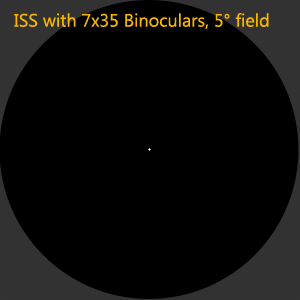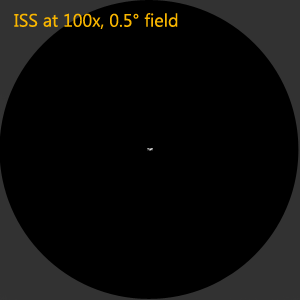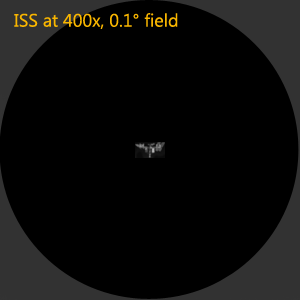Occasionally we get phone calls. People have an astronomy question and decide to call an observatory to get an answer. I would caution that this is generally not the best way to get an answer, Googling the question or looking it up on Wikipedia is much more likely to result in a usable answer. Usually our front desk will politely defer the caller to some other source, Shelly is very good at doing this.

Shelly is also a very nice lady who occasionally takes pity on some caller. Or the caller is very polite and asks very nicely. Often she forwards the call to me, knowing that I can usually answer these sort of questions.
What sort of telescope can be used to view the ISS?
At least the question did not involve aliens or NASA cover-ups, those question would have gotten the polite brush off from Shelly.
For someone who is inexperienced in using telescopes this not the easy place to start. Most of us who have been using telescopes for decades usually do not even try to do this. The space station is quite small and would require higher magnification to see well. It is also moving quite quickly across the sky. The combination of these two factors makes viewing the ISS a real challenge, to put it politely!
High magnification and high speed do not mix! As the magnification goes up, the field of view gets smaller, this makes it extraordinarily difficult to track the fast moving space station.
Of course, put a challenge before someone and they will figure out how to do it. Any number of amateur astronomers regard photographing the space station as a bit of a sport. The usual method is to calculate when the ISS will pass in front of the Sun or Moon, or simple an arbitrary spot in the sky. Then simply train the telescope on the correct place and start taking video just before the calculated time to catch a few images during the pass. At 60 frames per second the camera will allows a series of images as the station flies across the field of view.
Back to the callers original question. It breaks down into how much magnification you would need to see the space station well. As someone who is curious about such things I can not let the question go, not until I figure it out for myself.
First is to calculate the angular size of the space station. Angular size can be calculated easily using the equation below.
Θ = 206265 (L / R)
A quick check on Wikipedia gives the needed parameters, the orbital altitude and size of the space station. The station is 72.8m across (L) and has an average altitude of about 412km (R). Crunching the numbers gives an answer of 36 arcseconds.
This answer is quite comparable to viewing Jupiter or Saturn with a small telescope. Jupiter ranges in size between 30 and 50 arcseconds, while the rings of Saturn are about 36 to 44 arcseconds as seen in an earthbound telescope. From experience I can roughly say that you need at least 100x to begin seeing Jupiter or Saturn well.
Tracking the ISS by hand at 100x with a small telescope? Not going to be good. With a bit of practice you can probably do it, but the results will be less than satisfying. All you will get is a few jiggly glimpses. The video ambush technique at least works.
Taking these numbers I created a few simulated eyepiece views in Photoshop.

First up is binoculars, a pair of common 7×35 glasses with a 5° field of view. Yes that little dot is the resulting image. Actually I was generous, the calculation resulted in an image of 0.6 pixels across at the image scale I used here. I blurred that slightly as the station is very bright.
The conclusion is that with binoculars the station is simply a dot of light with no resolvable features. No reasonable size binoculars is going to show much more, even a pair of 14x100mm I have access to and could try. At least with binoculars you have a chance to track the station by hand.
The image I used is a NASA press release image of the ISS taken by Expedition 27 crew member Paolo Nespoli from the Soyuz TMA-20 following its undocking on May 23, 2011. I simply converted the image to greyscale, heavily blurred that and sized it as needed for each simulation.

Next up is a modest 100x view that could be easily managed with a small telescope. I assumed a standard Plössl eyepiece with a 50° apparent field resulting in a half degree field of view.
At this modest magnification a practiced amateur may be able to find and keep the station in view for a short while, but it would not be easy and the view quite jittery tracked by hand. At a mere six pixels across in this simulation there would not be much to see in the way of detail.
Of course the station could be tracked with a properly set up servo controlled mount. As this is a bit out of reach of a backyard amateur I exclude that capability in this discussion. I am not aware of any off-the-shelf commercial GOTO mount with this capability. Yes, again amateur astronomers have hacked together solutions that manage this feat, but the effort is considerable.
To be fair the human eye is very good at detecting fleeting detail in a momentary image. I expect that in practice a bit more detail might be seen than these simulated images suggest. These simulated images are only 300 pixels across to represent the eyepiece field. The resolution of the eye is a bit better than that.

The last simulation is at 400x. For this I calculated the view in a common 8″ SCT with a 2000mm focal length and a 5mm eyepiece to create a 400x view. The resulting field of view is about 0.1 degree or 6 arcminutes.
Finally a reasonable amount of detail begins to be visible. However, at this power tracking the station would be essentially impossible by hand.

